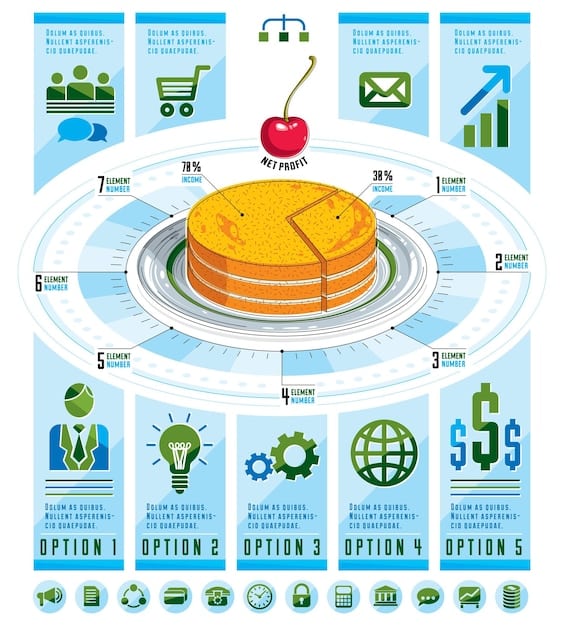How to Properly Recycle Electronics and Prevent E-Waste Pollution

To effectively recycle electronics and mitigate e-waste pollution, consumers should prioritize certified recycling programs, understand local regulations, and explore options for device reuse or donation to minimize environmental impact and recover valuable materials.
In an increasingly digital world, electronic devices have become indispensable, yet their rapid obsolescence presents a significant environmental challenge: electronic waste, or e-waste. Understanding how to properly recycle electronics and prevent e-waste pollution is not merely an option, but a critical imperative for global sustainability.
the growing tide of e-waste and its environmental impact
The ubiquity of electronic devices, from smartphones to refrigerators, has brought unparalleled convenience and connectivity. However, this technological boom comes with a significant downside: an ever-increasing volume of electronic waste (e-waste). Each year, millions of tons of discarded electronics contribute to a global crisis, marked by environmental degradation and health risks.
The environmental footprint of e-waste extends far beyond landfills. When electronics are improperly disposed of, they can leak hazardous substances like lead, mercury, cadmium, and beryllium into soil and groundwater. These toxins contaminate ecosystems, affect biodiversity, and can enter the human food chain, posing serious health threats.
the hidden dangers of improper disposal
Many consumers are unaware of the dangerous chemicals lurking within their discarded gadgets. These materials, while crucial for device functionality, become environmental hazards once they break down in landfills. The uncontrolled burning of e-waste further exacerbates the problem, releasing persistent organic pollutants and dioxins into the atmosphere.
Beyond the toxic components, e-waste represents a colossal loss of valuable raw materials. Devices contain precious metals like gold, silver, copper, and platinum, along with rare earth elements. Extracting these materials from virgin sources is energy-intensive and environmentally destructive. Recycling e-waste therefore conserves natural resources and reduces the demand for new mining operations.
Moreover, the informal recycling sector in developing countries often operates without proper safety measures, exposing workers and local communities to extreme health risks. This highlights the global interconnectedness of the e-waste problem and the urgent need for standardized, safe recycling practices worldwide. The volume of e-waste continues to climb, driven by rapid technological advancements and consumer demand for new devices, making effective recycling solutions more critical than ever.
Understanding the severe consequences of improper e-waste disposal is the first step towards promoting responsible consumption and recycling habits. Without proper channels, these discarded items will continue to accumulate, threatening both environmental health and human well-being for generations to come. The goal is to transition from a linear “take-make-dispose” economy to a circular one where resources are kept in use for as long as possible.
understanding the nuances of electronics recycling
Recycling electronics is not as straightforward as tossing a soda can into a blue bin. Electronics contain a complex mix of materials, some valuable and some hazardous, requiring specialized processes to disassemble and recover components safely. Understanding these nuances is key to effective e-waste management.
Broadly, electronics recycling involves several stages: collection, transportation, sorting, dismantling, and material recovery. Each step demands careful execution to ensure maximum resource recovery and minimal environmental impact. The initial collection phase is often the most challenging, as it relies heavily on public awareness and convenience of drop-off points.
the journey of a recycled device
- Collection: Devices are gathered through various channels, including municipal drop-off centers, retail take-back programs, and specialized recycling events.
- Sorting and Assessment: Collected electronics are sorted by type and condition. Some devices might be suitable for refurbishment and reuse, extending their lifespan.
- Dismantling: Devices are meticulously deconstructed, separating components like batteries, circuit boards, plastics, and metals. This step often involves manual labor and specialized tools.
- Material Recovery: Specific materials are then sent to specialized facilities for further processing. For instance, plastics might be shredded and melted, while metals undergo smelting to extract valuable elements.
The distinction between formal and informal recycling channels is crucial. Formal recyclers adhere to strict environmental and labor standards, ensuring safe handling of hazardous materials and proper disposal of non-recyclable components. Informal recyclers, prevalent in some parts of the world, often employ rudimentary and dangerous methods, leading to widespread pollution and health issues.
Moreover, not all electronics can be recycled in the same way. Large appliances like refrigerators have different requirements than small devices like headphones. Batteries, for instance, often need to be removed and recycled separately due to their chemical composition and potential for fire hazards. Education about these varying requirements is vital for consumers.
Ultimately, a robust electronics recycling infrastructure relies on collaboration between manufacturers, consumers, recyclers, and government agencies. Each entity plays a role in fostering a circular economy where electronic waste is transformed from a burden into a valuable resource, minimizing the need for virgin materials and reducing environmental strain.
identifying certified and responsible recycling programs
When it comes to recycling electronics, simply finding a drop-off point isn’t enough. Ensuring that your discarded devices are handled responsibly requires identifying and utilizing certified recycling programs. These programs adhere to stringent environmental, health, and safety standards, guaranteeing ethical and effective processing of e-waste.

In the United States, two prominent certifications signal a recycler’s commitment to best practices: R2 (Responsible Recycling) and e-Stewards. Both programs offer a framework for responsible electronics management, covering aspects from data security to environmental protection and worker safety. Choosing a certified recycler helps prevent hazardous materials from entering landfills and ensures valuable components are recovered.
key certifications and what they mean
- R2 (Responsible Recycling): This certification focuses on environmental performance, worker health and safety, data security, and responsible material management. R2 certified recyclers are audited regularly to ensure compliance with these standards.
- e-Stewards: Considered the most rigorous certification, e-Stewards ensures that no toxic electronic waste is exported to developing countries for processing, prohibits the use of prison labor, and mandates comprehensive data destruction protocols.
Beyond national certifications, many states and local municipalities offer their own e-waste collection programs, often in partnership with certified recyclers. Researching your local government’s waste management website is an excellent starting point to locate authorized collection sites or events. Some electronics retailers also offer take-back programs for their products, providing a convenient and often free recycling option.
When selecting a recycler, questions about their data destruction practices are paramount. Old devices often contain sensitive personal information that must be securely wiped before recycling. A reputable recycler will provide clear information on their data destruction methods, offering peace of mind that your privacy is protected.
It’s also beneficial to inquire about a recycler’s transparency. Responsible recyclers should be able to account for the fate of all materials they collect, demonstrating that components are recycled or disposed of in an environmentally sound manner, rather than being simply shipped overseas to informal operations. By choosing certified and transparent programs, consumers directly contribute to a sustainable and ethical e-waste management system.
preparing your devices for recycling: data security and removal
Before you hand over your old electronics for recycling, a critical step often overlooked is preparing the devices themselves. This primarily involves ensuring data security and removing any components that need separate handling. Neglecting these steps can lead to privacy breaches or environmental contamination.
The data stored on smartphones, laptops, and even smart home devices can be highly sensitive, ranging from personal photos and financial information to work documents. A simple factory reset often isn’t enough to permanently erase data, as recovery tools can sometimes retrieve seemingly deleted files. Therefore, dedicated data wiping procedures are essential.
essential steps for data protection
- Back Up Your Data: Transfer any important files, photos, or documents to a new device, an external hard drive, or cloud storage before proceeding with data erasure.
- Perform a Factory Reset AND Data Wipe: For most devices, a factory reset is a good starting point, but follow up with a secure data wiping utility. For hard drives, consider using software that performs multiple overwrites (e.g., DBAN for PCs) or physical destruction by a certified recycler if available.
- Remove SIM Cards and Memory Cards: Don’t forget to take out SIM cards from phones and memory cards from cameras or other devices. These small items can hold personal data.
Beyond data protection, certain components like batteries require special attention. Lithium-ion batteries, common in many portable electronics, can pose fire risks if damaged or improperly handled. Most certified recyclers will manage battery removal safely, but it’s crucial to be aware of this and avoid causing damage to batteries yourself. If a battery is swelling or leaking, it should be handled with extreme care and taken to a specialized battery recycling facility.
Always double-check if your device has any removable parts like external hard drives, accessory cards, or even decorative elements you might want to keep. Some devices also come with specialized parts that are designed to be removed and reused with other electronics. A thorough physical inspection of your device before recycling ensures that nothing valuable or personally identifiable is left behind.
Taking the time to properly prepare your devices not only protects your privacy but also aids the recycling process. Clean, securely wiped devices are easier and safer for facilities to process, contributing to a more efficient and effective recycling chain that benefits everyone.
beyond traditional recycling: reuse and donation options
While recycling is a crucial component of e-waste management, it’s not always the first or best option. Extending the lifespan of electronics through reuse and donation is often preferable, as it avoids the energy and resources required for breaking down and remanufacturing materials. Embracing these alternatives contributes significantly to a circular economy.
Many electronics, even if considered “old” by current standards, may still be perfectly functional for someone else. A laptop that’s too slow for graphic design might be ideal for a student’s basic coursework, or an older smartphone could serve as a reliable emergency phone or a device for a child’s educational games. Giving devices a second life reduces demand for new products and conserves valuable resources.
pathways to reuse and donation
- Charitable Organizations: Many non-profits accept donations of working electronics. They often refurbish these devices and provide them to low-income families, schools, or charities. Research local charities in your area for specific donation guidelines.
- Device Trade-In Programs: Electronics manufacturers and retailers frequently offer trade-in programs when you purchase a new device. They assess your old device’s value and either refurbish it for resale or ensure it’s properly recycled.
- Online Marketplaces: Platforms like eBay, Craigslist, or Facebook Marketplace allow you to sell or give away used electronics directly to individuals who can benefit from them. This provides an avenue for devices to find new homes.
Before donating or selling, ensure that the device is in good working condition and has been properly wiped of all personal data, as discussed in the previous section. If a device requires minor repairs, sometimes a little investment can make it suitable for reuse rather than recycling.
Some communities also have “freecycle” groups or repair cafes where you can offer items for free or get them repaired. These local initiatives foster community exchange and reduce waste by promoting repair and reuse. The key is to think creatively about how your device can continue to provide value before considering it truly “waste.”
Choosing to reuse or donate creates a positive social impact in addition to environmental benefits. It helps bridge the digital divide by providing access to technology for those who might not otherwise afford it, while simultaneously diverting e-waste from landfills. This approach embodies the true spirit of sustainability by maximizing utility and minimizing waste.
policy and manufacturer responsibility in e-waste management
While individual actions are crucial in managing e-waste, systemic change requires robust policy frameworks and greater responsibility from electronics manufacturers. Governments worldwide are increasingly recognizing the need for legislation to address e-waste, promoting extended producer responsibility (EPR) and fostering a circular economy.
Extended Producer Responsibility (EPR) is a policy approach in which producers are given significant responsibility—financial and/or physical—for the treatment or disposal of post-consumer products. For electronics, this means manufacturers might be required to fund or manage take-back and recycling programs for their products once they reach end-of-life. This incentivizes design for durability, repairability, and recyclability.

key policy and industry initiatives
- Right to Repair Legislation: Growing movements advocate for “right to repair” laws, which would require manufacturers to make repair manuals, spare parts, and diagnostic tools available to consumers and independent repair shops. This aims to extend device lifespans and reduce premature disposal.
- Eco-Design Principles: Progressive manufacturers are integrating eco-design principles into their product development, focusing on modularity, ease of disassembly, use of recycled materials, and avoidance of hazardous substances in new electronics.
- Global E-waste Conventions: International agreements like the Basel Convention regulate the transboundary movement of hazardous wastes, including e-waste, aiming to prevent its illegal shipment to countries with inadequate processing capabilities.
However, the implementation and enforcement of these policies vary significantly across regions. Challenges include lobbying from manufacturers, difficulties in establishing effective collection infrastructure, and the informal e-waste trade. There is a continuous push for more harmonized and ambitious global policies.
Consumers can play a role in advocating for these systemic changes by supporting brands committed to sustainability and engaging with local and national policy discussions. Demand for more repairable, durable, and ethically sourced electronics sends a clear signal to the market.
Ultimately, a sustainable future for electronics rests on a collective effort: responsible consumption by individuals, innovation and accountability from manufacturers, and supportive legislation from governments. By intertwining these efforts, we can build a more resource-efficient and less polluting electronics industry, turning the tide on the growing e-waste crisis.
the future of e-waste: innovation and the circular economy
The challenge of e-waste is immense, but the future holds promise through technological innovations and a deeper commitment to the principles of a circular economy. Moving beyond traditional recycling, the focus is shifting towards designing out waste and pollution from the very beginning of a product’s lifecycle.
The concept of a circular economy aims to keep resources in use for as long as possible, extract the maximum value from them whilst in use, then recover and regenerate products and materials at the end of each service life. For electronics, this means prioritizing not just recycling, but also repair, refurbishment, remanufacturing, and even product-as-a-service models where consumers lease devices rather than owning them.
emerging solutions and trends
- Advanced Material Recovery: New technologies are being developed to more efficiently extract rare earth elements and precious metals from complex electronic assemblies, making recycling more economically viable and environmentally sound.
- Robotics and AI in Recycling: Automation and artificial intelligence are beginning to play a role in sorting and dismantling electronics, increasing efficiency and safety in recycling facilities.
- Modular and Repairable Designs: Some manufacturers are experimenting with modular designs that allow for easy repair and component upgrades, significantly extending a device’s useful life and reducing the frequency of replacement.
Blockchain technology is also being explored to track electronics throughout their lifecycle, providing transparency and accountability from manufacturing to end-of-life. This could help combat illegal e-waste dumping and ensure that materials are responsibly managed at every stage.
Micro-factories capable of on-site e-waste processing and urban mining initiatives are also gaining traction. These localized solutions reduce transportation emissions and create localized job opportunities in the recycling sector. The emphasis is on transforming waste into a resource, reducing reliance on virgin materials and mitigating environmental impact.
Educating consumers about the benefits of repair, reuse, and thoughtful consumption will be paramount. A shift in mindset from constant upgrades to valuing durability and longevity is essential for the circular economy to flourish. The ultimate goal is a future where “e-waste” becomes an outdated term, replaced by a continuous flow of valuable materials circulating within a sustainable technological ecosystem.
| Key Aspect | Brief Description |
|---|---|
| 🗑️ E-Waste Impact | Toxic chemicals contaminating soil, water, and air; loss of valuable metals. |
| ✅ Certified Recycling | Choose R2 or e-Stewards certified recyclers for safe and ethical processing. |
| 🔒 Data Security | Securely wipe data, remove SIM/memory cards, back up files before disposal. |
| ♻️ Reuse & Donate | Extend device lifespan through donations, trade-ins, or online marketplaces. |
frequently asked questions about e-waste recycling
E-waste, or electronic waste, refers to discarded electrical or electronic devices. This includes a wide range of items such as computers, televisions, mobile phones, home appliances, and even toys with electronic components. It is a rapidly growing waste stream due to technological advancements and consumer turnover.
Proper electronic recycling is vital because electronics contain toxic elements like lead, mercury, and cadmium that can harm the environment and human health if improperly disposed. Additionally, they contain valuable rare earth metals and precious materials that can be recovered and reused, reducing the need for new mining.
You can find certified e-waste recyclers by visiting the websites of certification bodies like R2 (Responsible Recycling) or e-Stewards, which offer searchable databases. Many local government waste management websites also list approved collection sites, as do certain electronics retailers with take-back programs.
Before recycling, always back up any important data, then perform a factory reset followed by a secure data wipe using specialized software. Physical destruction of hard drives can also be an option through certified recyclers. Don’t forget to remove SIM cards and memory cards from devices.
Yes, absolutely. Donating or reusing functional electronics is often the most environmentally friendly option, as it extends the device’s lifespan and reduces the need for new manufacturing. Look for local charities, trade-in programs, or online marketplaces that accept used electronics in good working condition.
conclusion
The journey to effectively manage electronic waste is a shared responsibility, extending from product design to end-of-life disposal. Understanding how to properly recycle electronics and prevent e-waste pollution is more than just a convenient practice; it’s a profound commitment to environmental stewardship and public health. By choosing certified recyclers, protecting our personal data, and exploring avenues for reuse and donation, each of us contributes significantly to mitigating the growing e-waste crisis. As technology continues its relentless march forward, our collective efforts in adopting a circular economy model for electronics become increasingly vital, ensuring that innovation does not come at the cost of our planet’s well-being.





